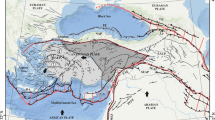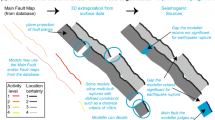Abstract
Identification and characterization of active faults and deciphering their seismic potential are of vital importance in seismic hazard assessment of any region. Seismic vulnerability of India is well known as more than 60 % of its area lies in high hazard zones due to the presence of major active faults in its plate boundaries and continental interiors, which produced large earthquakes in the past and have potential to generate major earthquakes in future. The safety of critical establishments, like Power plants, Refinaries and other lifeline structures is a major concern in these areas and calls for a better characterization of these faults to help mitigate the impact of future earthquakes. The paper provides a brief overview of the work carried out in India on active fault research, its limitations and immediate priorities.
Similar content being viewed by others
References
Dasgupta, S. and 14 others (2000) Seismotectonic Atlas of India and its Environs. Geol. Surv. India Publ.
Dasgupta, S., Mazumdar, K., Moirangcha, L.H., Dutta Gupta, T. and Mukhopadhyay, B. (2013) Seismic landscape from Sarpang re-entrant, Bhutan Himalaya foredeep, Assam, India: Constraints from geomorphology and geology. Tectonophysics, v.592, pp.130–140.
Joshi, D.D. and Tandon, S.K. (1987) Jour. Geol. Soc. India, v.29, pp.540–553.
Joshi, P.N., Maurya, D.M. and Chamyal, L.S. (2013) Morphotectonic segmentation and spatial variability of neotectonic activity along the Narmada-Son Fault, Western India: Remote sensing and GIS analysis. Geomorphology, v.180–181 pp.292–306.
Kumar, S., Wesnousky, S.G., Rockwell, T.K., Briggs, R.W., Thakur, V.C. and Jayangondaperumal, R. (2006) Paleoseismic evidence of great surface rupture earthquakes along the Indian Himalaya. Jour. Geophys. Res., v.111, B03304. Doi: 10.1029/2004JB003309.
Kumar, S., Wenousky, S.G., Jayangondaperumal, R., Nakata, T., Kumahara, Y. and Singh, V. (2010) Paleoseismological evidence of surface faulting along the northeastern Himalayan Front, India: timing, size, and spatial extent of great earthquakes, Jour. Geophys. Res., v.115, B12422. doi: 10.1029/2009JB006789.
Malik, J.N. and Nakata, T. (2003) Active faults and related late Quaternary deformation along the NW Himalaya Frontal Zone, India. Annals of Geophysics, v.46(5), pp.917–936.
Malik, J.N., Shah, A.A., Sahoo, A.K., Puhan, B., Banerjee, C., Dattatraya, P.S., Juyal, N., Singhvi, A.K. and Rath, S.K. (2010) Active fault, fault growth and segment linkage alonge the Janauri anticline (frontal) foreland fold), NW Himalaya, India. Tectonophysics, v.483, pp.327–343.
Nakata, T. (1989) Active faults of the Himalaya of India and Nepal. Geol. Soc. Amer. Spec. Paper, v.232, pp.243–264.
Oldham, R.D. (1899) Report of the Great Earthquake of 12th June, 1897. Mem. Geol. Surv. India, v.29, pp.1–379.
Oldham, R.D. (1926) The Cutch (Kachh) earthquake of 16th June, 1819 with reivision of the Great Earthquake of 12th June, 1897: Mem. Geol. Surv. India, v. 46(2), pp.118–141.
Pande, P., Sharda, Y.P., Ghevaria, Z.G., Joshi, K.C. and John, B. (2003) Coseismic structural ground deformation. In: P. Pande and J.R. Kayal (Eds.), Kutch (Bhuj) Earthquake, 26 January 2001, Geol. Surv. India Spec. Publ., No.76, pp.163–171.
Pande, P., Venkatraman, N.V., Gupta, S.K. and Venkatraman, B. (1994) Terrain changes and associated features consequent to Killari earthquake of 30th Sept., 1993. Geol. Surv. India Spec. Publ., No. 27, pp.215–220.
Philip, G. (1995) Active tectonics in Doon valley. Jour. Himalayan Geol., v.6(2), pp 55–61.
Philip, G. and Sah, M.P. (1999) Geomorphic signatures for active tectonics in the Trans-Yamuna segment of the western Doon valley, NW Himalaya. Internat. Jour. Appld. Earth Observation and Geoinformation, v.1, pp.54–63.
Rajendran, K., Rajendran, C.P., Thakkar, M. and Tuttle, M.P. (2001) The 2001 Kutch (Bhuj) earthquake: Coseismic surface features and their significance. Curr. Sci., v.80(11) pp.1397–1405.
Sukhija, B.S., Lakshmi, B.V., Rao, M.N., Reddy, D.V., Nagabhushanam, P., Hussain, S. and Gupta, H.K. (2006) Widespread Geologic Evidence of a large Paleoseismc event near the Meizoseismal Area of the 1993 Latur Earthquake, Deccan Shield, India. Jour. Indian Geophys Union, v.10(1), pp.1–14.
Valdiya, K.S. (1984) Aspects of tectonics, Focus on South-Central Asia (Tata McGraw-Hill Publishing Company Ltd., New Delhi), pp.319.
Valdiya, K.S. (1993) Uplift and geomorphic rejuvenation of the Himalaya in the Quaternary period. Curr. Sci., v.64, pp.873–885.
Verma, M. and Bansal, B.K. (2013) Seismic hazard assessment and mitigation in India: an overview. Internat. Jour. Earth Sci., DOI: 10.1007/s00531-013-0882-8.
Wenousky, S.G., Kumar, S., Mohindra, R. and Thakur, V.C. (1999) Uplift and convergence along the Himalayan Frontal Thrust. Tectonics, v.18(6), pp.967–976.
Author information
Authors and Affiliations
Corresponding author
Rights and permissions
About this article
Cite this article
Verma, M., Bansal, B.K. Active fault mapping: An initiative towards seismic hazard assessment in India. J Geol Soc India 82, 103–106 (2013). https://doi.org/10.1007/s12594-013-0128-1
Received:
Accepted:
Published:
Issue Date:
DOI: https://doi.org/10.1007/s12594-013-0128-1




